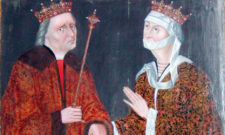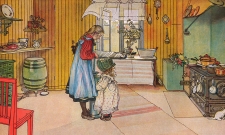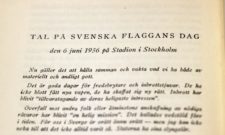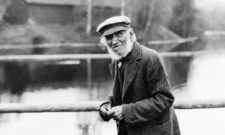Shop our historical maps
Culture
Lucia - one of the Swedish people's most beloved traditions

Dec
Lucia, the "queen of light", lights up the Nordic winter darkness every winter and heralds Christmas on 13 December. Malin Kim tells us about one of our most beloved traditions.
Tomorrow morning, fireworks will be lit in thousands of Swedish homes, schools and workplaces. The song rings out, the shadows roar and some shed a tear as the children's choir chimes in.
How is it that a Catholic saint is celebrated in this way in our de-Christianized country, when for most Catholics outside the Nordic countries she is just one of hundreds of other saints, a name in the almanac that the great masses do not even know?
The answer is that our Lucia is a prime example of how Swedish culture and tradition has emerged from outside impulses mixed with age-old Swedish traditions, thus becoming, over the centuries, a unique celebration that only we and the Swedish-speaking people of Finland celebrate.
Herman Lindqvist
The text above is a quote from historian Herman Lindqvist. His description is an excellent example of how not only the Lucia tradition, but also cultures as a whole have evolved. When people claim that Swedish culture does not exist, they usually mean that we have received cultural influences from outside. But according to such reasoning, no cultures would exist at all - no currently existing culture is free from the influence of others. The uniqueness of each culture lies in how it has processed, selected and reshaped its content, and in this respect Swedish culture is no different from any other. Let us therefore look at how the celebration of St Lucia, perhaps one of our most beautiful and cherished traditions, has evolved.
The Lucia celebration originates from the legend of Saint Lucia from Sicily, whose name means "light". She was born in the 280s, when Christianity was forbidden in the Roman Empire and therefore practised her religion in secret. When she was unwillingly betrothed to a non-Christian man, she was so disappointed that she chose to give away her dowry to the poor. In revenge, the man revealed her as a Christian and she was executed on 13 December 304, giving rise to a cult of saints. Today's Lucia celebrations, however, have little to do with this saint worship.
In the Nordic countries, 13 December was a special day even before the tradition of Lucia processions emerged. In the old peasant society, when the Julian calendar was used, the night of 13 December was the longest of the year. With the calendar reform, the winter solstice was moved to 21 December, but the idea of the long and dark Lucian night remained. Supernatural beings were thought to be in motion and animals were thought to be able to speak. People kept watch through the night.
In western Sweden, Lucia Day grew into a major holiday. There it was called "little Christmas Eve" or "lusse langnatt" and those who could feasted on large quantities of food. A German tradition, according to which a girl was dressed as "Christkindlein" (a baby Jesus with candles in her hair to symbolise the glory) was picked up in Sweden, but was transformed into a grown woman with luciakrona on his head carried out food. The oldest record of a light-adorned Lusseau bride is from Horn outside Skövde in 1764. During the 19th century, the custom spread to university towns and in the 1890s Skansen organised a Lucia celebration to showcase provincial festive traditions. Lucia appeared alone or with a couple of companions.
The Lucia procession in the form of a light-bearing Lucia with an entourage is a more recent phenomenon, which only became common in the 1920s. The Lucia procession took on its present character after a competition was announced in Stockholms Dagblad in 1927, in which the chosen Lucia was given a chandelier and led a procession of bridesmaids. The procession was supplemented by star boys, who had traditionally gone around singing in the cottages during Advent to represent the three wise men. The event became popular and similar celebrations were recreated around the country. As Lucia processions began to be organised in schools and nurseries, the train was augmented by Santa's elves and gingerbread men.
In modern times, the Lucia celebrations have become one of the Swedish people's most beloved traditions. Lucia has become a "queen of light" who comes every winter to light up the Nordic winter darkness and herald the coming of Christmas. The celebrations take place everywhere - in town squares, workplaces, schools, old people's homes, hospitals and private homes. Many of us know the traditional carols by heart and associate Lucia with a sense of celebration and peace.
Print sources:
Modéus, Martin (2000), Tradition and life, Verbum Swahn, Jan-Öjvind (2007), Swedish traditions, Ordalaget
Unprinted sources:
http://www.aftonbladet.se/nyheter/kolumnister/hermanlindqvist/article12701170.abhttps://www.nordiskamuseet.se/aretsdagar/luciahttps://www.svenskakyrkan.se/luciahttps://sweden.se/culture-traditions/lucia/ Originally published on Cultural memory.
Subscribe to YouTube:
If you appreciate Allmogens independent work to portray our fine Swedish history and Nordic culture, you are welcome to buy something nice in the shop or support us with a voluntary donation. Thank you in advance!
Support Allmogens via Swish: 123 258 97 29
Support Allmogens by becoming a member
Support Allmogens in your will









This is fundamentally wrong. The "Lucia celebration" (which does not exist and never has existed) does not originate from any Italian saint. It has its origins in the celebration of the LUCIA, which goes back to ancient pagan traditions, older than both asa and vanatro, which was a celebration of the winter solstice.
The association with the saint Lucia was something that the Catholic Church forced on people to combat the pagan faith. As is usually the case when power forces artificial constructs on people, today the link to Lucia has completely died out while the tradition of celebrating Lusse lives on.
The expression has changed throughout history, but it is always the ancient Germanic and pagan tradition that we celebrate. Since the Germanic peoples originated in southern Sweden, Lusse is a Swedish tradition, regardless of the way it has been celebrated throughout history.
The tradition of Lucia is fascinating because few seem to know how it actually came about. I've read about Lussi and the old traditions of lusti as a magical night, in many places. What I have long wondered is: when did the Italian saint come into the picture? And how? Is it shrouded in mystery or is there any evidence of when it happened? Sweden had a Lutheran church already in the 17th century, and Swedish churches definitely did not celebrate saints. The tradition of Lucia in its modern form, the official city Lucia, started, according to sources, in the 1920s? In the 1920s, the Church of Sweden was not very close to the Catholic Church, so it seems unlikely that it would have happened then. So would it have happened in the 16th century, or earlier? The use of the Italian melody, to which we now sing "Luciasången" ( there are three versions of the text) was in any case done in the 1920s. In connection with the arrival of the "city lucian". Writing a text about "Lucia with lights in her hair" was brilliant. The original, the melody, is Italian, but the original text has nothing to do with the saint Lucia. It's about a neighbourhood in Naples. Ingeniously, the name of the district was Sancta Lucia. Was it because the Church thought that the word 'Lussi' was similar to the word 'Lucia', and did they pick on this saint in the Middle Ages, in order to curb popular traditions? I have heard that the stargazing has its roots in the Catholic Church's ambition to portray the message of the Bible, by having people dress up as the characters of the Bible, the Gospel of Christmas, and go around singing with a big star. "Star procession". But there was no "Lucia" in those trains from what I heard. Grateful for literature suggestions, where one can possibly read about this.
The question is when did this happen? Was it already in the 16th century that the saint Lucia was applied to Swedish Lussi celebrations? I have been looking for the answer. In any case, what I heard from films with ethnologist Ebbe Schön was that the Star Train was a remnant of the Catholic Church's ambition to portray the Christmas gospel with costumed young people. But Joseph, Mary, the wise men and Herod.The star boys were created to emphasize the star, as it says in the Bible. There was no Lucia as far as I understand.Later these trains also became a bit more of a joyous prank among young people, young men going around knocking on doors and singing - to get some food, drink and a penny. When did the saint come into the picture?
Pingback: SWEA Lucia procession and Christmas dinner at IKEA - SWEA Houston